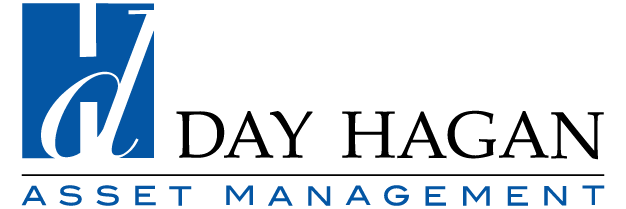Day Hagan Tech Talk: The Collective We
A downloadable PDF copy of the Article: Day Hagan Tech Talk: The Collective We (pdf)
Summary
Who knows better, Wall Street economists or the “collective we,” the stock market?
Complement, Not Compete
Our recent reports and last week’s Chart Jamboree emphasized a cautious stance as we approached month-end and an overbought near-term condition. A major concern is the U.S. consumer, strained by a mixed economic environment. This raises a question: should we prioritize what the majority of Wall Street’s economists think about the U.S. consumer and focus on the weakening economic backdrop—evidenced by CarMax’s results, escalating geopolitical tensions, slowing employment, rising unemployment claims, sticky inflation, and growing attention on a potential government shutdown (which could impact Friday’s job report)? Or should we lean on the stock market’s collective wisdom, defined in this case by the Consumer Discretionary proxy (Figure 1)?
While I lean toward the “collective we,” Day Hagan has long advocated that the various forms of Wall Street analysis—economic, fundamental, quantitative, and technical—should complement each other, not compete. Success in the challenging world of investing is hard enough without bringing ego into the decision-making process.
Figure 1: Consumer Discretionary proxies. | Withstanding a breakdown below support (green lines), this chart suggests that U.S. consumers are holding their own.
As Don Hagan recently penned, “U.S. economic growth is just fine for now. Q2 U.S. real annualized GDP was revised up to 3.8%, and Q3 is looking pretty good, too.”
At the Same Time
Historically, a negative correlation has existed between the direction of the U.S. Dollar Index and the price direction of commodities. A lower-trending U.S. Dollar Index has traditionally been a catalyst for higher commodity prices. That has been the case in 2025 for many, but not all, commodities. The U.S. Dollar Index trended lower (from January to June), while many commodities have consistently trended higher, albeit at different times and varying rates of change this year.
Recently, however, the U.S. Dollar Index has traded sideways (from June to the present) and has even started to rally (Figure 2), while individual commodities have either continued to rally or begun to trend higher, forming their own new uptrends. Our research partners at 3Fourteen Research wrote of gold:
Classically, we would expect this mix to be bearish for gold. Yet, as we mentioned, gold is sitting right at its highs. All of this is bull market behavior. No matter what the “squiggles” of rates or the Dollar suggest, investors should not abandon the gold trade.
To borrow some of their thoughts, the current dynamics in commodities signal bull market behavior. No matter what the Dollar suggests, investors should not abandon the commodity complex just yet. Seek opportunities (Figure 3) and continually manage risk through hedging, reducing exposure, or exiting losing positions based on your timeframe and tolerance for risk.
Figure 2: U.S. Dollar Index. | Even with all the disdain for the U.S. Dollar, it hasn’t broken down. Chart configuration has transitioned from Bearish to “Bearish to Neutral.” See commentary within the chart.
Figure 3: Palladium (spot price). | Please refer to the commentary within the chart and continue to manage risk.
Aligning with the theme of opportunities within the commodity complex, seasonal factors—though secondary indicators in our work—offer insight. Over the past five years (a relatively small sample), Crude Oil is up 75% of the time during October, with an average gain of 2.4%. Similarly, between 2020 and 2024, the Energy Select Sector SPDR (XLE) averaged a 5.3% increase and was up 60% of the time during October.
Please let me know if you’d like a chart for either.
Note: As we approach the end of the year, the S&P 500 cycle composite for 2025 is nearing its cycle low point. Here are some areas to watch for the S&P 500 (6661.21):
Support: 6569 (minor), 6551 (short-term), 6540 to 6500 (uptrend line drawn off late May low), and 6467 (rising 50-day MA).
Resistance: 6700+/-, upper 6700.
The Day Hagan Smart Sector Strategies incorporate built-in risk management parameters relating to sector allocation and equity-versus-cash allocation. Please let me know if you would like to schedule a call to discuss the process and discipline underpinning our Smart Sector with Catastrophic Stop, Smart Sector International, and Smart Sector Fixed Income strategies. Disclosures and Fact Sheets can be found here: https://dhfunds.com/literature.
Day Hagan Asset Management appreciates being part of your business, either through our research efforts or investment strategies. Please let us know how we can further support you.
Art Huprich, CMT®
Chief Market Technician
Day Hagan Asset Management
—Written 09.28-29.25. Chart source: Stockcharts.com unless otherwise noted.
Disclosure
The data and analysis contained herein are provided “as is” and without warranty of any kind, either express or implied. Day Hagan Asset Management (DHAM), any of its affiliates or employees, or any third-party data provider, shall not have any liability for any loss sustained by anyone who has relied on the information contained in any Day Hagan Asset Management literature or marketing materials. All opinions expressed herein are subject to change without notice, and you should always obtain current information and perform due diligence before investing. DHAM accounts that DHAM, or its affiliated companies manage, or their respective shareholders, directors, officers and/or employees, may have long or short positions in the securities discussed herein and may purchase or sell such securities without notice. The securities mentioned in this document may not be eligible for sale in some states or countries, nor be suitable for all types of investors; their value and income they produce may fluctuate and/or be adversely affected by exchange rates, interest rates or other factors.
Investment advisory services offered through Donald L. Hagan, LLC, a SEC registered investment advisory firm. Accounts held at Raymond James and Associates, Inc. (member NYSE, SIPC) and Charles Schwab & Co., Inc. (member FINRA, SIPC). Day Hagan Asset Management is a dba of Donald L. Hagan, LLC.
